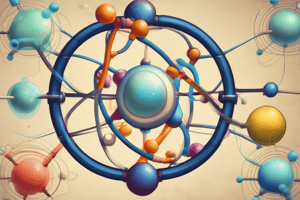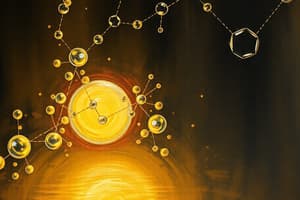Podcast
Questions and Answers
What are examples of hydrogen bond donors?
What are examples of hydrogen bond donors?
- Strong acids, weak acids, molecules containing C−H bonds (correct)
- Alcohols, aldehydes, ketones
- Amines, ethers, alkenes
- Strong bases, noble gases, alkanes
Which atoms are considered hydrogen bond acceptors?
Which atoms are considered hydrogen bond acceptors?
- P, S, I
- F, O, N (correct)
- C, H, Cl
- Na, Mg, Al
What is the experimental criterion for the existence of a hydrogen bond between A and B?
What is the experimental criterion for the existence of a hydrogen bond between A and B?
- A B distance in A − H B is about 3.5 to 4.0 Å
- A B distance in A − H B is about 4.0 to 4.5 Å
- A B distance in A − H B is about 1.0 to 1.5 Å
- A B distance in A − H B is about 2.8 to 3.0 Å (correct)
What is the quantum mechanical description of hydrogen bonds?
What is the quantum mechanical description of hydrogen bonds?
What do hydrogen bonds provide a path for?
What do hydrogen bonds provide a path for?
What is the primary method for calculating entropy and free energy for a system?
What is the primary method for calculating entropy and free energy for a system?
What is used to calculate the force on each atom of a molecule in the molecular dynamics method?
What is used to calculate the force on each atom of a molecule in the molecular dynamics method?
What is the purpose of simulated annealing in molecular dynamics calculations?
What is the purpose of simulated annealing in molecular dynamics calculations?
What determines the conformations of macromolecules?
What determines the conformations of macromolecules?
What characterizes which reactions occur and which species or conformations are present at equilibrium?
What characterizes which reactions occur and which species or conformations are present at equilibrium?
What are dipole moments measures of?
What are dipole moments measures of?
What do dipole-dipole interactions involve?
What do dipole-dipole interactions involve?
What do London interactions involve?
What do London interactions involve?
What is Van der Waals repulsion?
What is Van der Waals repulsion?
How is the London-van der Waals interaction represented?
How is the London-van der Waals interaction represented?
What do noncovalent interactions show?
What do noncovalent interactions show?
What does the lowest energy conformation involve?
What does the lowest energy conformation involve?
What is the total energy in the lowest energy conformation?
What is the total energy in the lowest energy conformation?
What do energy calculations involve in molecular interactions?
What do energy calculations involve in molecular interactions?
What do hydrogen bonds contribute to?
What do hydrogen bonds contribute to?
What do hydrophobic effects help determine?
What do hydrophobic effects help determine?
What determines many of the physical properties of a substance?
What determines many of the physical properties of a substance?
What is the potential energy equation based on Coulomb's law?
What is the potential energy equation based on Coulomb's law?
What is the permittivity constant?
What is the permittivity constant?
What does the interaction of two charges in a nonpolar membrane depend on?
What does the interaction of two charges in a nonpolar membrane depend on?
What do net atomic charges provide insights into?
What do net atomic charges provide insights into?
What does the potential energy equation for electrostatic energy involve?
What does the potential energy equation for electrostatic energy involve?
What is the permittivity constant for water?
What is the permittivity constant for water?
What do net atomic charges provide a qualitative picture of?
What do net atomic charges provide a qualitative picture of?
What do the results of approximate calculations of net atomic charges align with?
What do the results of approximate calculations of net atomic charges align with?
What do hydrocarbons have a permittivity constant of 2 and water have a permittivity constant of 80 represent?
What do hydrocarbons have a permittivity constant of 2 and water have a permittivity constant of 80 represent?
What does Coulomb's law describe?
What does Coulomb's law describe?
What determines whether the forces described by Coulomb's law are attractive or repulsive?
What determines whether the forces described by Coulomb's law are attractive or repulsive?
What does the permittivity constant represent in Coulomb's law?
What does the permittivity constant represent in Coulomb's law?
What does the potential energy in the context of Coulomb's law refer to?
What does the potential energy in the context of Coulomb's law refer to?
What does the net atomic charges provide insights into?
What does the net atomic charges provide insights into?
What do the forces of attraction between atoms and molecules determine?
What do the forces of attraction between atoms and molecules determine?
What is the value of the permittivity constant for water?
What is the value of the permittivity constant for water?
What does the interaction of two charges in a nonpolar membrane compared to when they are surrounded by water?
What does the interaction of two charges in a nonpolar membrane compared to when they are surrounded by water?
What does the net atomic charges provide a qualitative picture of?
What does the net atomic charges provide a qualitative picture of?
What do various forces of attraction between the atoms and molecules of a substance determine?
What do various forces of attraction between the atoms and molecules of a substance determine?
Flashcards are hidden until you start studying
Study Notes
Molecular Interactions and Energy Calculations
- Dipole moments are measures of molecule polarity, calculated based on charge distribution and symmetry.
- Dipole-dipole interactions involve attraction or repulsion between molecules based on their dipole moments.
- London interactions, named after Fritz London, involve fluctuation-induced dipole attraction between atoms.
- Van der Waals repulsion, named after Joannes Diderik van der Waals, is a universal repulsion between atoms and molecules at short distances.
- The London-van der Waals interaction is represented by the 6-12 potential, summing attractive and repulsive energies.
- Noncovalent interactions, such as charge-charge, dipole-dipole, and London attraction, show long-range charge-charge interactions and short-range London attraction.
- The lowest energy conformation involves bonded interactions like bond stretching, angle bending, and torsion angle rotation, as well as nonbonded interactions.
- Total energy in the lowest energy conformation is the sum of bond stretching, angle bending, and nonbonded interaction energies.
- Energy calculations involve docking for predicting molecular interactions and calculating interaction energy.
- Hydrogen bonds, mediated by a hydrogen atom between electronegative atoms, contribute to the energy of a structure.
- Hydrophobic effects help determine protein folding, membrane fit, and lipid interactions in water.
- Understanding entropy in condensed phases, such as phospholipid bilayers and micelles, is challenging in computational chemistry.
Studying That Suits You
Use AI to generate personalized quizzes and flashcards to suit your learning preferences.




